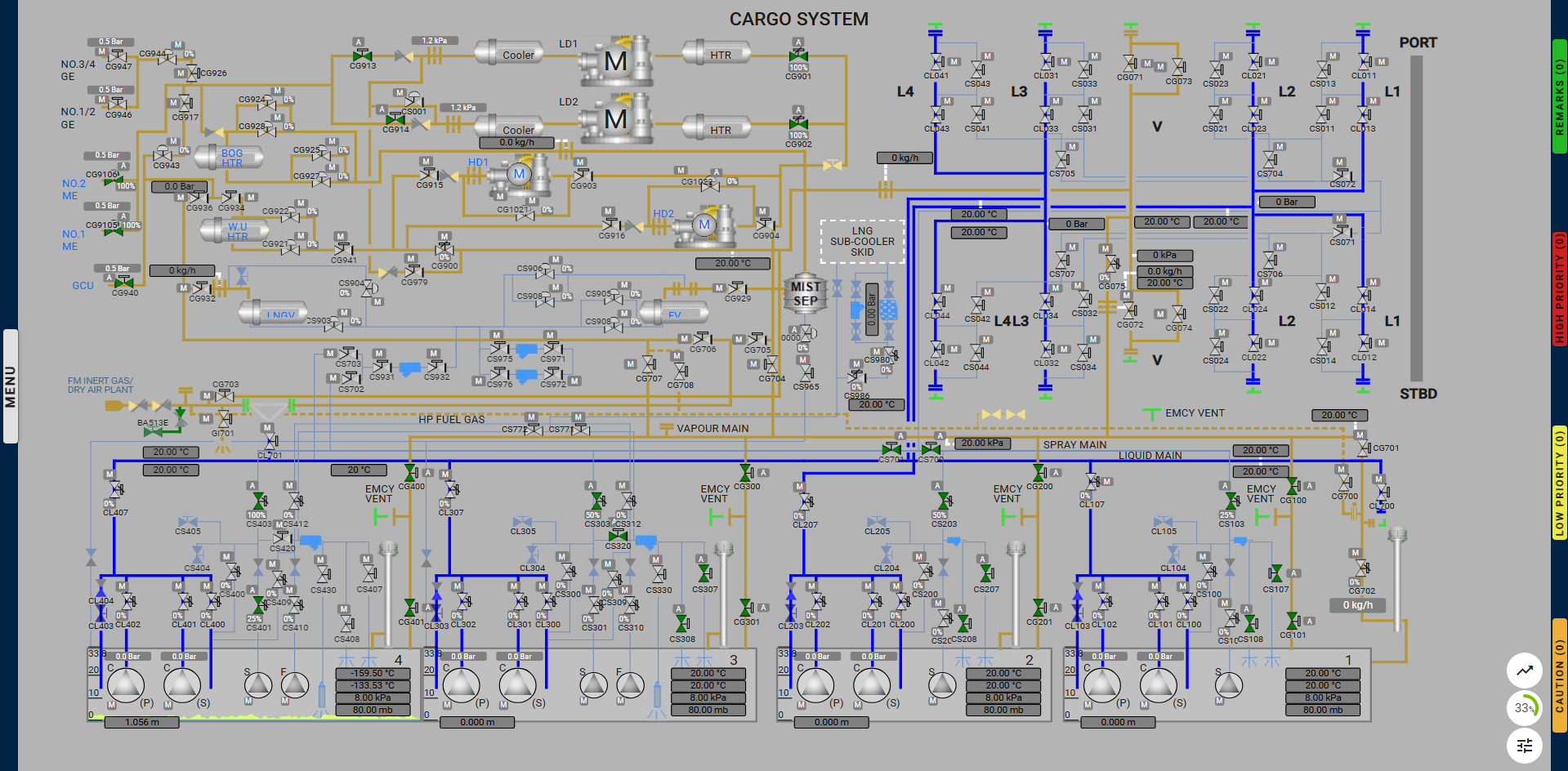

This exercise focuses on the operation of cooling down cargo tanks onboard an LNG carrier. When the vessel is en route to the loading port, there is typically some quantity of heel remaining in the cargo tanks. The vessel uses this heel to cool down the other tanks, which are in a warm-up condition due to the length of the voyage.
This operation is similar to the extended cool-down from shore; however, the key difference is that the LNG used for the cooling process is sourced from the onboard heel, rather than from the shore.
Liquid LNG is introduced from the Heel tank with the help of the Spray Pump and directed toward the cargo tanks via spray lines, which contain spray nozzles inside the tanks. The LNG is sprayed into the tanks, gradually lowering the temperature. The goal is to reach a loading temperature of -130°C inside all cargo tanks. The vapor pressure inside the tanks is managed by running the LD compressor and consuming in the Engines.
Prepare the high-duty compressor and generators for operation. Connect the spool pieces. Ensure the correct valves are lined up to direct the LNG into the tanks via the spray lines.
The assessment begins once the lineup is complete and all equipment is ready for operation. The LNG flow is started from the spray pump, and the user must achieve a temperature of -130°C inside the tanks. Throughout the assessment, the user must maintain the correct LNG flow in order to achieve the temperature drop in the requisite time period and respond to any rising tank pressure by operating the LD compressor appropriately. The Gas Combustion Unit is put on standby in case required.
The exercise is considered complete when the target temperature of -130°C is reached inside all cargo tanks within the stipulated time. The user is assessed based on their response to various remarks, cautions, and alarms presented during the exercise.
Learning Objectives for the Exercise
Participants will be able to effectively demonstrate the process of cooling down cargo tanks on LNG ships when at sea, understanding the necessary safety protocols, operational procedures, and the importance of achieving the required temperatures for safe LNG loading.
Key Components:
Understanding Cooling Down:
Operational Procedures:
Monitoring and Verification:
Practical Demonstration:
Assessment Criteria:
By achieving this objective, participants will gain the knowledge and skills necessary for safely and efficiently cooling down cargo tanks on LNG ships while at sea, ensuring operational readiness for LNG loading.
Deviation From Exercise:
Reduce Temperature Drop Rate During Stage I:
Reduce Temperature Drop Rate During Stages II & III:
Close One Nozzle in Cargo Tanks Below 0°C:
Start LD Compressors:
|
Alarm Condition |
Alarm Time | Alarm Level | Alarm Title | Alarm Description |
Action |
|
When prerequisite milestones for starting the cooldown are completed. |
Before Starting Cooldown | Remark | Begin the cooldown process with a low flow rate. |
Begin the cooldown with a low flow of 25 m³/h. |
|
|
Tank Middle Temp <= 5°C |
When particular tank middle sensor temperature reaches 5°C | Remark | Reduce Master Valve Opening In CT 1,2,3,4 |
Reduce the master valve opening to at least 25% For CT1 and 50% For CT2,CT3,CT4. |
|
|
Valve not closed to required percentage, after receiving the remark |
After 1 minute of receiving the remark alarm | Caution | Reduce Master Valve Opening In CT 1,2,3,4 |
Reduce the master valve opening to at least 25% For CT1 and 50% For CT2,CT3,CT4. |
|
|
Tank Middle Temp <= 0°C |
When particular tank middle sensor temperature reaches 0°C | Remark | Close One Nozzle In CT 1,2,3,4. |
Close one spray nozzle in cargo tank 1 and continue cooldown. |
|
|
One Nozzle Not Closed After Receiving the Remark(And Action Not Taken). |
5 minutes after receiving the remark | Low Priority | Close One Nozzle In CT 1,2,3,4. |
Close one spray nozzle in cargo tank 1 and continue cooldown. |
|
|
One Nozzle Not Closed After Receiving the low priority (And Action Not Taken). |
5 minutes after receiving the low priority | High Priority | Close One Nozzle In CT 1,2,3,4. |
Close one spray nozzle in cargo tank 1 and continue cooldown. |
|
|
whenever temperature drop exceeds the max level. |
Whenever the drop is more than -17°C during stage 1 or 11°C during stage 2. | Caution | High Temperature drop in CT1,2,3,4. |
High temperature drop in CT1,2,3,4, Adjust master valve CS103,203,303,403 or reduce the flow from shore. |
|
|
Cargo Tank Pressure >= 14 kpa |
Caution | Start LD Compressor | High pressure inside the tanks, start the LD compressor. | ||
|
Cargo Tank Pressure >= 16 Kpa |
Caution | Start Another LD
Compressor |
Start another LD compressor. |
Preparing Generators for Use:
Open all required valves for the line-up.
|
Valve |
Status/Position |
|
CS401 |
Open |
|
CS701 |
Open |
|
CS700 |
Open |
|
CS103 |
25% |
|
CS107 |
Open |
|
CS108 |
Open |
|
CS203 |
50% |
|
CS207 |
Open |
|
CS208 |
Open |
|
CS303 |
50% |
|
CS307 |
Open |
|
CS308 |
Open |
|
CS320 |
Open |
|
CG100 |
Open |
|
CG101 |
Open |
|
CG200 |
Open |
|
CG201 |
Open |
|
CG300 |
Open |
|
CG301 |
Open |
|
CG400 |
Open |
|
CG401 |
Open |
|
CG901 |
Open |
|
CG902 |
Open |
|
CG914 |
Open |
|
CG913 |
Open |
|
CG940 |
Open |
|
CG9105 |
100% |
|
CG9106 |
100% |
Test Run GCU:
Start Spray Pump in Cargo Tank 4:
Cooldown Process:
Completion:
Achieve -130°C in all three tanks to complete the exercise.
